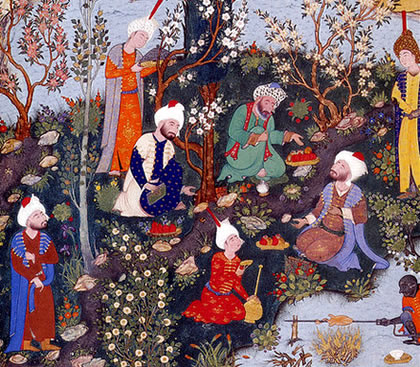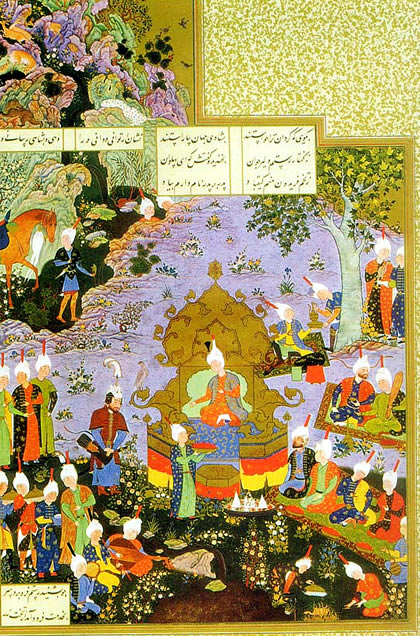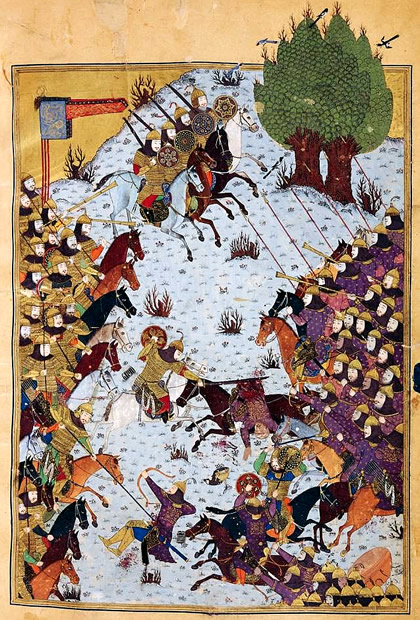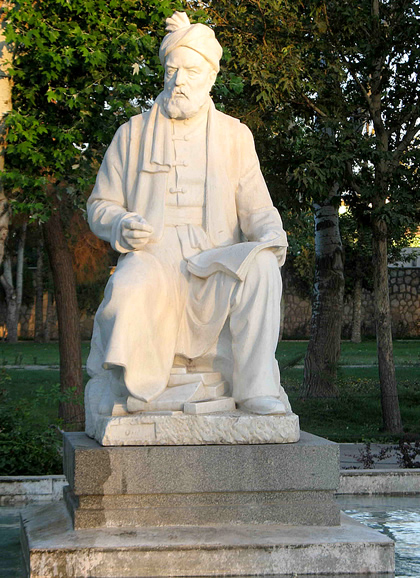World History
The Shahnamah (various spellings) is a central epic of Persian literature written by the poet Firdawsi (various spellings) in approximately the year 1010. It is an epic poem of considerable length, which aims to recount the history and achievements of the Persian people and their kings.
Using the earlier Khvatay-namak, which was a prose epic covering the Persian people from the mythic past to the seventh century, Firdawsi rewrote the prose in verse form and extended the tale to include the Sassanid period.
He wrote this under the sponsorship of Sultan Mahmud of Ghazni and it endures as a central part of modern Persian culture, extending beyond modern Iran into Central Asia and the Indian subcontinent.
Firdawsi wrote his epic, which is known in English as the Epic of Kings, in a form of verse couplets known as masnavi. The effect of the epic was to Persianize the people within the territories claimed by Persian kings, irrespective of their original ethnic and religious affiliations.
Because of the Islamization of Persia, the Shahnamah has been cast within a worldview strongly influenced by Islamic thought. The Persian heroes, such as Rustam, were recreated within this context.
Just as in the case of Jewish verse histories, a number of which cover apparently the same incidents from a different perspective, the Shahnamah acts to provide a centralizing narrative, which was used by state builders to help integrate a set of diverse peoples into a single nation.
The story itself covers a bewildering variety of individuals, kings, heroes, and notable people of the past, as well as the defining events of their lives. Although the majority of individuals disappear from the narrative quickly, many have distinctive characteristics and are comparatively sophisticated in terms of characterization.
Both good and evil appear to be combined in the characters. Previous religious beliefs, notably Zoroastrianism, are presented as having been defeated by the newly arrived faith.
However the more than 60 stories and 60,000 couplets allow for considerable latitude in interpretation. The material is deliberately composed in such a way as to invite the reader to ponder on the events of the past and to seek the moral lessons to be learned from them.
Misunderstandings, unrequited love, hubris, and jealousy are all present. The epic serves jointly as a history and a repository of moral and religious truths, and an artistic masterpiece in its own right.
- Ghaznavids
Ghaznavids The Ghaznavid dynasty ruled eastern Afghanistan and parts of Iran and Pakistan from 977 to 1186. Sebuk Tigin (r. 977–997), a former slave, founded the empire, ruling from the city of Ghazna, from which the dynasty obtained its name....
- Hafiz - Persian Poet
Haï¬z - Persian Poet Hafiz, a pen name for Khajeh Shamseddin Mohammad Shirazi, was born in Shiraz in present-day Iran. Following the death of his father, a merchant, Hafiz lived in poverty until his poetry earned him the patronage of several Persian...
- Hindu Epic Literature
Hindu Epic Literature The most famous Hindu epic literature arose in India during the Vedic period (c. 1000–c. 500 b.c.e), which helped define the essentials of Indian belief and culture. While Hinduism is not the sole religion in the region, these...
- The 300
I am very excited about a new film opening next week. It is 300 which is an account of the famous Greek last stand at the Battle of Thermopylae in 480 BC. At that battle, a small handful of Greeks slowed the Persians down and inflicted anywhere from 20...
- Criticism Of The First Persian Gulf War In Three Kings
Criticism of the First Persian Gulf War in Three Kings Article which reviews the political tone of the film Three Kings which focused on Iraq and the First Persian Gulf War. I personally didn't like the film but this is a good analysis of the political...
World History
Shahnamah
 |
| Shahnamah |
The Shahnamah (various spellings) is a central epic of Persian literature written by the poet Firdawsi (various spellings) in approximately the year 1010. It is an epic poem of considerable length, which aims to recount the history and achievements of the Persian people and their kings.
Using the earlier Khvatay-namak, which was a prose epic covering the Persian people from the mythic past to the seventh century, Firdawsi rewrote the prose in verse form and extended the tale to include the Sassanid period.
  |   |
He wrote this under the sponsorship of Sultan Mahmud of Ghazni and it endures as a central part of modern Persian culture, extending beyond modern Iran into Central Asia and the Indian subcontinent.
Firdawsi wrote his epic, which is known in English as the Epic of Kings, in a form of verse couplets known as masnavi. The effect of the epic was to Persianize the people within the territories claimed by Persian kings, irrespective of their original ethnic and religious affiliations.
Because of the Islamization of Persia, the Shahnamah has been cast within a worldview strongly influenced by Islamic thought. The Persian heroes, such as Rustam, were recreated within this context.
 |
| one of the page inside shahnamah epic |
Just as in the case of Jewish verse histories, a number of which cover apparently the same incidents from a different perspective, the Shahnamah acts to provide a centralizing narrative, which was used by state builders to help integrate a set of diverse peoples into a single nation.
The story itself covers a bewildering variety of individuals, kings, heroes, and notable people of the past, as well as the defining events of their lives. Although the majority of individuals disappear from the narrative quickly, many have distinctive characteristics and are comparatively sophisticated in terms of characterization.
Both good and evil appear to be combined in the characters. Previous religious beliefs, notably Zoroastrianism, are presented as having been defeated by the newly arrived faith.
 |
| Battle scene ilustration |
However the more than 60 stories and 60,000 couplets allow for considerable latitude in interpretation. The material is deliberately composed in such a way as to invite the reader to ponder on the events of the past and to seek the moral lessons to be learned from them.
Misunderstandings, unrequited love, hubris, and jealousy are all present. The epic serves jointly as a history and a repository of moral and religious truths, and an artistic masterpiece in its own right.
 |
| Firdawsi statue |
- Ghaznavids
Ghaznavids The Ghaznavid dynasty ruled eastern Afghanistan and parts of Iran and Pakistan from 977 to 1186. Sebuk Tigin (r. 977–997), a former slave, founded the empire, ruling from the city of Ghazna, from which the dynasty obtained its name....
- Hafiz - Persian Poet
Haï¬z - Persian Poet Hafiz, a pen name for Khajeh Shamseddin Mohammad Shirazi, was born in Shiraz in present-day Iran. Following the death of his father, a merchant, Hafiz lived in poverty until his poetry earned him the patronage of several Persian...
- Hindu Epic Literature
Hindu Epic Literature The most famous Hindu epic literature arose in India during the Vedic period (c. 1000–c. 500 b.c.e), which helped define the essentials of Indian belief and culture. While Hinduism is not the sole religion in the region, these...
- The 300
I am very excited about a new film opening next week. It is 300 which is an account of the famous Greek last stand at the Battle of Thermopylae in 480 BC. At that battle, a small handful of Greeks slowed the Persians down and inflicted anywhere from 20...
- Criticism Of The First Persian Gulf War In Three Kings
Criticism of the First Persian Gulf War in Three Kings Article which reviews the political tone of the film Three Kings which focused on Iraq and the First Persian Gulf War. I personally didn't like the film but this is a good analysis of the political...
